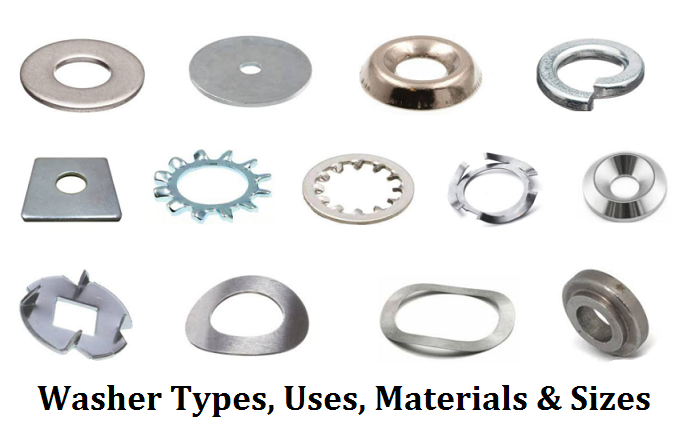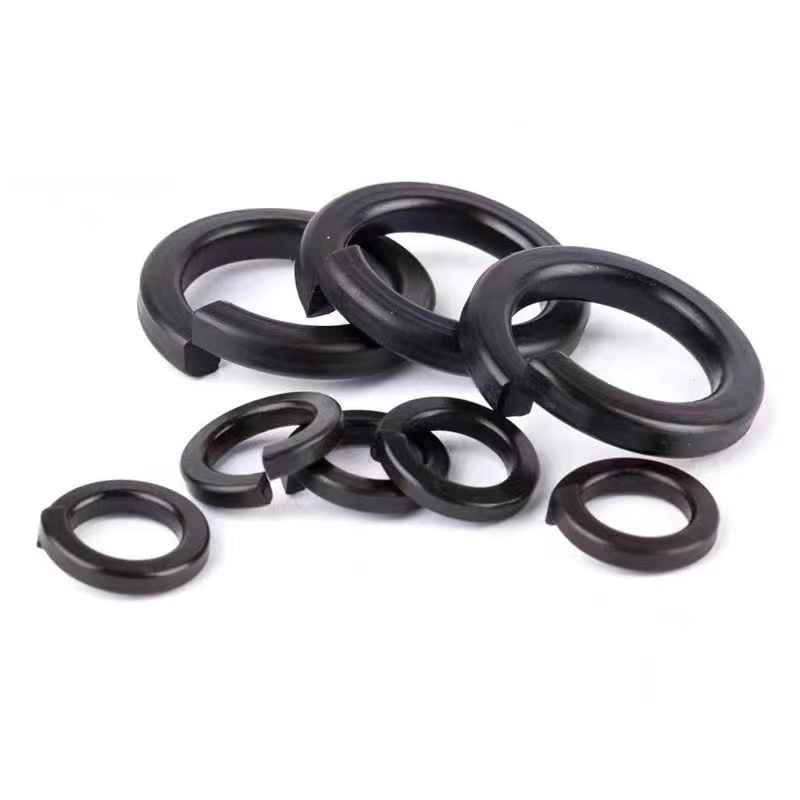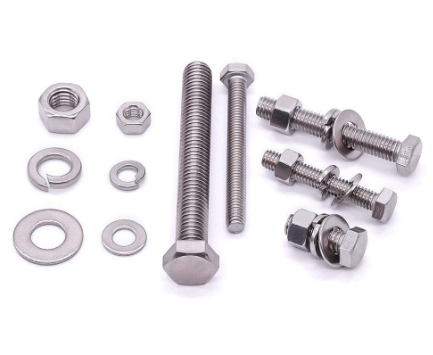The humble flat washer is a ubiquitous yet often overlooked metal component used in countless mechanical assemblies. While simple in design, flat washers serve important functions that enhance the performance and longevity of bolted joints. Properly selected and installed, washers can stabilize bolt heads, distribute clamping loads evenly, prevent damage to mated parts, and act as lock washers to counter loosening. This guide provides an overview of flat washers, including their key purposes, common materials and finishes, standard sizing specifications, the variety of types available, and how to calculate their weight. Understanding how and when to implement washers allows engineers and technicians to maximize the effectiveness of bolt fastening applications.
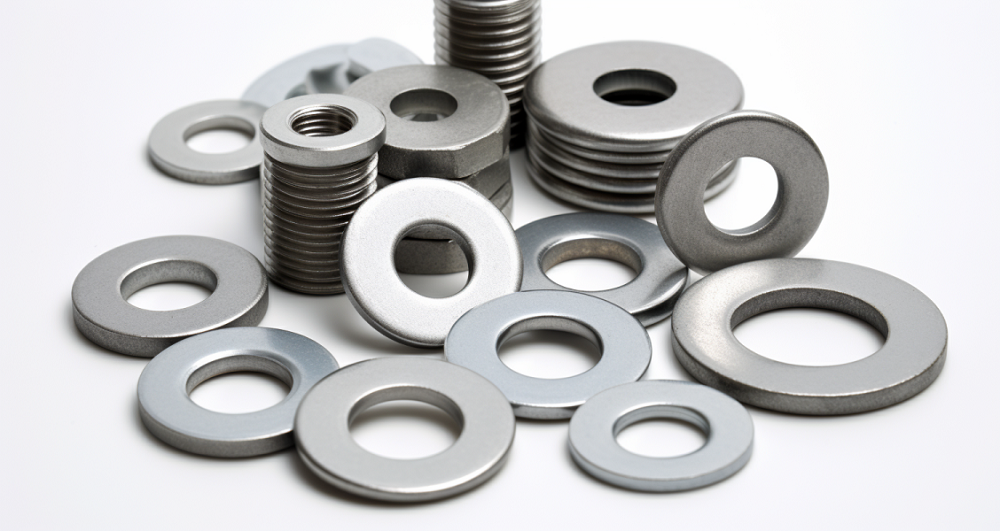
What is a Flat Washer?
Generally, the term “seating surface (washer)” refers to a flat washer. When the hole diameter of the mating material is larger than the screw, the seat surface of the screw head becomes wider with a flat washer, improving contact with the mating material and stabilizing the screw head. As it presses the member over a wide area, it also serves as a lock washer. Special size flat washers are a series that has developed specifications to allow a wider selection of outer diameters and thicknesses compared to conventional flat washers (flat washers). They are also called round washers or plain washers.
Features of Flat Washers:
Flat washers (washers) are placed between the tightening parts, such as small screws or bolts during tightening. In addition to iron and stainless steel, materials such as rubber, silicone, and plastics are also available. These have the effect of preventing damage to materials and improving airtightness. Generally, the term “washer” refers to this flat washer.
When looking closely, metal flat washers have subtly different shapes on their two surfaces (although there is no official distinction between front and back). Some washers, like cut washers and resin washers, have the same shape on both sides.
There is no strict rule for which side to place facing the part, but the smoother, more aesthetically pleasing “front” side is often placed facing outward, where it is more visible.
What is the Purpose of a Flat Washer?
Flat washers (washers) are used in various places and are components that many people know, but surprisingly many people do not actually know their real role. With only the screw seat surface, the contact area becomes small, so the tightening force per unit area becomes too strong, resulting in damage to the contact surface. By widening the area with the same tightening force, the pressure can be dispersed to prevent contact surface damage. It can be said that it is unnecessary for permanent use, but for disassembly purposes or where the mating surface is a soft material, inserting a flat washer improves durability.
Flat Washer Uses
Here is what the flat washer is used for:
- Prevent the bolt or nut head from sinking into holes or grooves of parts, or to stabilize the seat when the hole diameter is larger than the bolt diameter
- Prevent damage to materials
- Serve as lock washers (increase friction with washer for better locking) by pressing the part over a wide area
- Hide underside holes
- Used for the above purposes. Flat washers are also used to stabilize the seat when holes are larger than the bolt head to prevent bolts or screws from falling out.
- Washers × Resin are also used for insulation and to improve waterproofing and airtightness!
Flat Washer Materials
Flat washers made of non-metallic materials such as rubber, silicone, and resin are also used. The roles of flat washers made of these materials are different from metal ones – they are used to improve air tightness or protect parts from damage. Here are the main materials of washers:
- Iron
- Brass
- Stainless steel
- Aluminum
- Titanium
- SUS316L
- ZAM
- SUS329J4L
Flat Washer Surface Coating & Finishing
- Bare
- Chrome
- Trivalent chrome
- Trivalent black chrome
- Nickel
- Chrome
- Dacro
- SUS black
- Black nickel
- Ruffle
- Diomet
- Trivalent stenocoat
- Dob
- Parker
- Black chrome
- Etc.
Flat Washer Types & Specifications
There are actually very many types of flat washers, including those with special dimensions. In general circulation, there are common specifications and ISO specifications, and they are further divided into large washers and small washers with subtle dimension differences. However, unless absolutely necessary, the common standards and ISO specifications generally do not distinguish products based only on dimensions. Considering that ISO specifications are the newer standards and will have greater circulation in the future, it may be better to standardize on ISO specifications when considering the future.
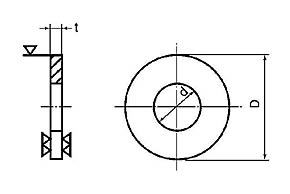
Flat Washer Dimensions
| Nominal Diameter of Washer | M2 | M3 | M4 | M5 | M6 | M8 | M10 | |
| Inner Diameter | 2.2 | 3.2 | 4.3 | 5.3 | 6.4 | 8.4 | 10.5 | |
| Outer Diameter | Small Series | 4.5 | 6 | 8 | 9 | 11 | 15 | 18 |
| Parallel Series | 5 | 7 | 9 | 10 | 12 | 16 | 20 | |
| Large Series | 6 | 9 | 12 | 15 | 18 | 24 | 30 | |
| Thickness | Small Series | 0.3 | 0.5 | 0.5 | 1 | 1.6 | 1.6 | 1.6 |
| Parallel Series | 0.3 | 0.5 | 0.5 | 1 | 1.6 | 1.6 | 1.6 | |
| Large Series | 0.5 | 0.8 | 1 | 1.2 | 1.6 | 2 | 2.5 | |
Flat Washer Size Chart (ISO Specifications)
ISO (International Organization for Standardization) specifies standard dimensions for flat washers. The ISO standards for flat washers include ISO 7089, ISO 7090, and others, which cover plain washers of steel with or without chamfer. The following chart includes typical sizes for ISO flat washers, but please note that actual sizes may vary, and there can be additional sizes not listed here.
ISO Flat Washer Size Chart (Metric – MM)
| ISO Designation | Nominal Size | Inner Diameter (ID) | Outer Diameter (OD) | Thickness (T) |
| ISO 7089/7090 | M2 | 2.2 | 5 | 0.3 |
| ISO 7089/7090 | M2.5 | 2.7 | 6 | 0.5 |
| ISO 7089/7090 | M3 | 3.2 | 7 | 0.5 |
| ISO 7089/7090 | M4 | 4.3 | 9 | 0.8 |
| ISO 7089/7090 | M5 | 5.3 | 10 | 1 |
| ISO 7089/7090 | M6 | 6.4 | 12 | 1.6 |
| ISO 7089/7090 | M8 | 8.4 | 16 | 1.6 |
| ISO 7089/7090 | M10 | 10.5 | 20 | 2 |
| ISO 7089/7090 | M12 | 13 | 24 | 2.5 |
| ISO 7089/7090 | M14 | 15 | 28 | 2.5 |
| ISO 7089/7090 | M16 | 17 | 30 | 3 |
| ISO 7089/7090 | M20 | 21 | 37 | 3 |
| ISO 7089/7090 | M24 | 25 | 44 | 4 |
| ISO 7089/7090 | M30 | 31 | 56 | 4 |
| ISO 7089/7090 | M36 | 37 | 66 | 5 |
The ISO 7089 and ISO 7090 standards have slight differences. ISO 7089 refers to flat washers without chamfer, while ISO 7090 refers to flat washers with a chamfer. The dimensions outlined in the table generally apply to both types unless otherwise specified by the standard.
These sizes are indicative and widely used in engineering, but for exact specifications and additional sizes, the ISO standards documents should be consulted. Moreover, for critical engineering applications, always ensure that the correct grade of washer is selected according to the requirements for material, hardness, and other physical properties.
The flat washer size charts might also categorize washers by standard sizes (like metric or imperial), material types (such as stainless steel, brass, etc.), and specific use cases or standards (like automotive, aerospace, etc.). Below is a chart that lists common sizes for flat washers according to the Imperial system and the Metric system:
Imperial Flat Washer Size Chart (Inches)
| Size | Inside Diameter (ID) | Outside Diameter (OD) | Thickness |
| #6 | 0.149 | 0.375 | 0.031 |
| #8 | 0.174 | 0.375 | 0.031 |
| #10 | 0.203 | 0.437 | 0.032 |
| 1/4″ | 0.281 | 0.625 | 0.065 |
| 5/16″ | 0.344 | 0.688 | 0.065 |
| 3/8″ | 0.406 | 0.812 | 0.065 |
| 7/16″ | 0.469 | 0.922 | 0.065 |
| 1/2″ | 0.531 | 1.062 | 0.083 |
| 5/8″ | 0.656 | 1.312 | 0.083 |
| 3/4″ | 0.812 | 1.469 | 0.108 |
| 7/8″ | 0.938 | 1.750 | 0.108 |
| 1″ | 1.062 | 2.000 | 0.108 |
Metric Flat Washer Size Chart (MM)
| Size | Inside Diameter (ID) | Outside Diameter (OD) | Thickness |
| M2 | 2.2 | 5 | 0.3 |
| M2.5 | 2.7 | 6 | 0.5 |
| M3 | 3.2 | 7 | 0.5 |
| M4 | 4.3 | 9 | 0.8 |
| M5 | 5.3 | 10 | 1 |
| M6 | 6.4 | 12 | 1.6 |
| M8 | 8.4 | 16 | 1.6 |
| M10 | 10.5 | 20 | 2 |
| M12 | 13 | 24 | 2.5 |
| M14 | 15 | 28 | 2.5 |
| M16 | 17 | 30 | 3 |
| M20 | 21 | 37 | 3 |
| M24 | 25 | 44 | 4 |
Please note that the actual washer dimensions can vary slightly depending on the manufacturer and the standard to which they are made (such as ASTM, SAE, USS, DIN, etc.).
Flat Washer Weight Calculator
Calculating the weight of a flat washer requires knowledge of its dimensions and the material it’s made of. The weight can be calculated using the following formula:
Weight = Volume × Density
The volume of a washer can be found by calculating the volume of the cylinder (as if it were a solid disc) and subtracting the volume of the inner hole:
Volume = π × (Outer Radius² – Inner Radius²) × Thickness
Here’s a step-by-step guide to calculate the weight of a flat washer:
- Measure the Washer Dimensions:
- Outer diameter (OD)
- Inner diameter (ID)
- Thickness (T)
- Calculate the Radii:
- Outer radius (R_out) = OD / 2
- Inner radius (R_in) = ID / 2
- Calculate the Volume in Cubic Meters (or any unit of volume):
- Volume (V) = π × (R_out² – R_in²) × T
- Determine the Material Density in kg/m³ (or any unit of mass per unit volume):
- For example, the density of steel is approximately 7850 kg/m³.
- Calculate the Flat Washer Weight:
- Weight (W) = Volume × Density
This formula assumes a flat, uniform washer without any significant variation in thickness or density.
Here’s an example calculation for a steel washer:
- Outer diameter (OD): 20 mm
- Inner diameter (ID): 10 mm
- Thickness (T): 2 mm
- Density of steel (ρ): 7850 kg/m³
First, convert the dimensions to meters (if your dimensions are not already in meters):
- R_out = 20 mm / 2 = 10 mm = 0.01 m
- R_in = 10 mm / 2 = 5 mm = 0.005 m
- T = 2 mm = 0.002 m
Now calculate the volume:
- V = π × (0.01² – 0.005²) × 0.002 m³
- V = π × (0.0001 – 0.000025) × 0.002 m³
- V = π × 0.000075 × 0.002 m³
- V ≈ 3.14 × 0.000075 × 0.002 m³
- V ≈ 0.00000047 m³
Finally, calculate the weight:
- W = V × ρ
- W = 0.00000047 m³ × 7850 kg/m³
- W ≈ 0.003689 kg or 3.689 grams
The weight of the washer is approximately 3.689 grams.
Please note that in practice, you’d want to ensure that your density is in the correct units to match your volume units for the weight calculation to be accurate. Also, the precision of the weight calculated depends on the precision of the original measurements and the exact density of the material.



